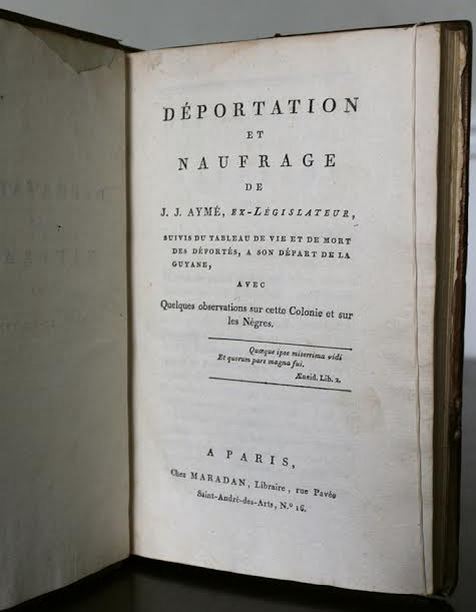Cayenne, The Dry Guillotine. Part 3/3: Jean-Jacques Aymé, Affliction of Job
- by Thibault Ehrengardt

Deportation et Naufrage
A sort of Escape
When Ramel and his companions decided to run away from Sinnamary, it was a matter of life or death—and it was a straightforward escape. They crawled out of the fort where they were held prisoners, stole a small boat, putting their lives at risk by joining Dutch Guyana by sea. Aymé’s escape was far less romantic. As the political situation had changed in France, the deportees were convinced that they would soon be granted the right to join the island of Oleron, off France—which was a much more enviable fate. Everyday they expected the ship from France to enter Cayenne’s port with the said authorization. But time was getting short for Aymé: “Stuck with the danger of my bad health and the agitations of the colony, (...) and not seeing any vessel arrive from France, persuaded that I was authorized to repair to Oleron, and apprehensive of falling before I departed, I formed the resolution of seeing (an) American captain, named Gardner, and of proposing him to take me on board his vessel.” Aymé apparently had more money than Pitou or Ramel; this made his stay in hell much more comfortable. He paid the American captain and prepared to leave Guyana with two friends, Parizot and Perlet. But Barbé-Marbois and Lafond-Ladebat were more determined than ever not to run away from the wrath of their tyrants, and Aymé didn’t tell them about his project, which was soon carried out. “After having offered up our thanksgiving to the Supreme Being, Parizot, Perlet, and myself, embraced each other, as men who had just miraculously escaped death.” Aymé wrote that he intended to join Oleron, but his ship was wrecked on the coast of Scotland during a terrible tempest—he almost perished at the occasion, and he gave quite a detailed description of this adventure.
Unlike Ramel and Pitou, Jean-Jacques Aymé didn’t make it to the various historical dictionaries. He died in 1818, leaving this interesting testimony of a dark period in French history. His book is probably less fascinating than the two other ones, but its dull and resentful tone gives an idea of what these people went through in French Guyana. And it was just a beginning. Indeed, the deportations weren’t about to stop. In fact, a penitentiary was built in Cayenne—in the Anse du Chaton—in 1852 by Louis-Napoléon Bonaparte, who sent many political prisoners there. The “dry guillotine” remained very efficient: between 1854 and 1867, 17,000 prisoners were deported to Cayenne, and only 7,000 survived. At the end of the century, the Communards, who had rebelled against the government in 1871, were sent to Cayenne—including the famous Louise Michèle. But the penitentiary soon welcomed the ordinary recidivists—including Henri Charrière, made famous by Franklin J. Schaffner’s movie Papillon (1973). In 1938, the French government officially closed down the penitentiary, but the last deportees didn’t come back to France before 1953. This terrible place gave birth to many books and engravings (by the prisoners themselves most of the time). And the Zoummeroff sale that took place in Paris last year (see article) proved that many people are still interested in the fates of the people, guilty or not, who survived—or not—the tropical blade of the dry guillotine.
Thibault Ehrengardt